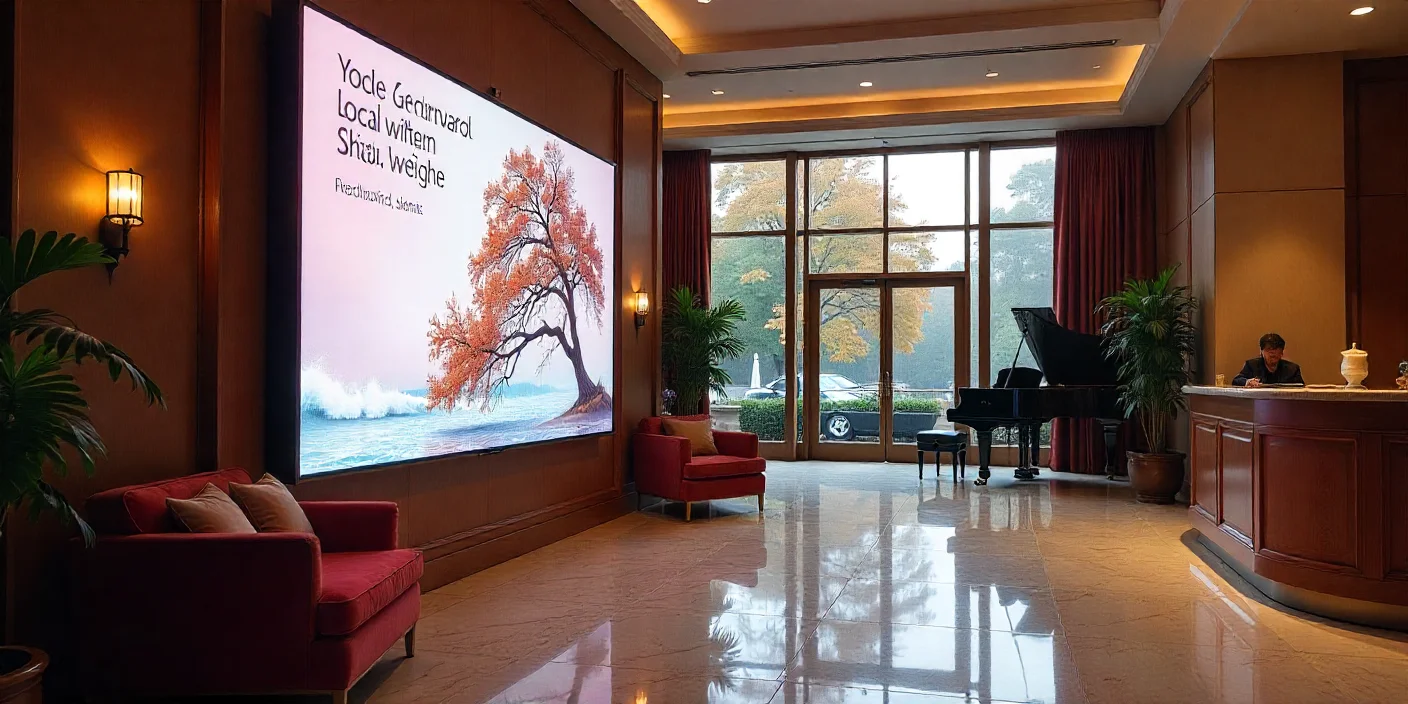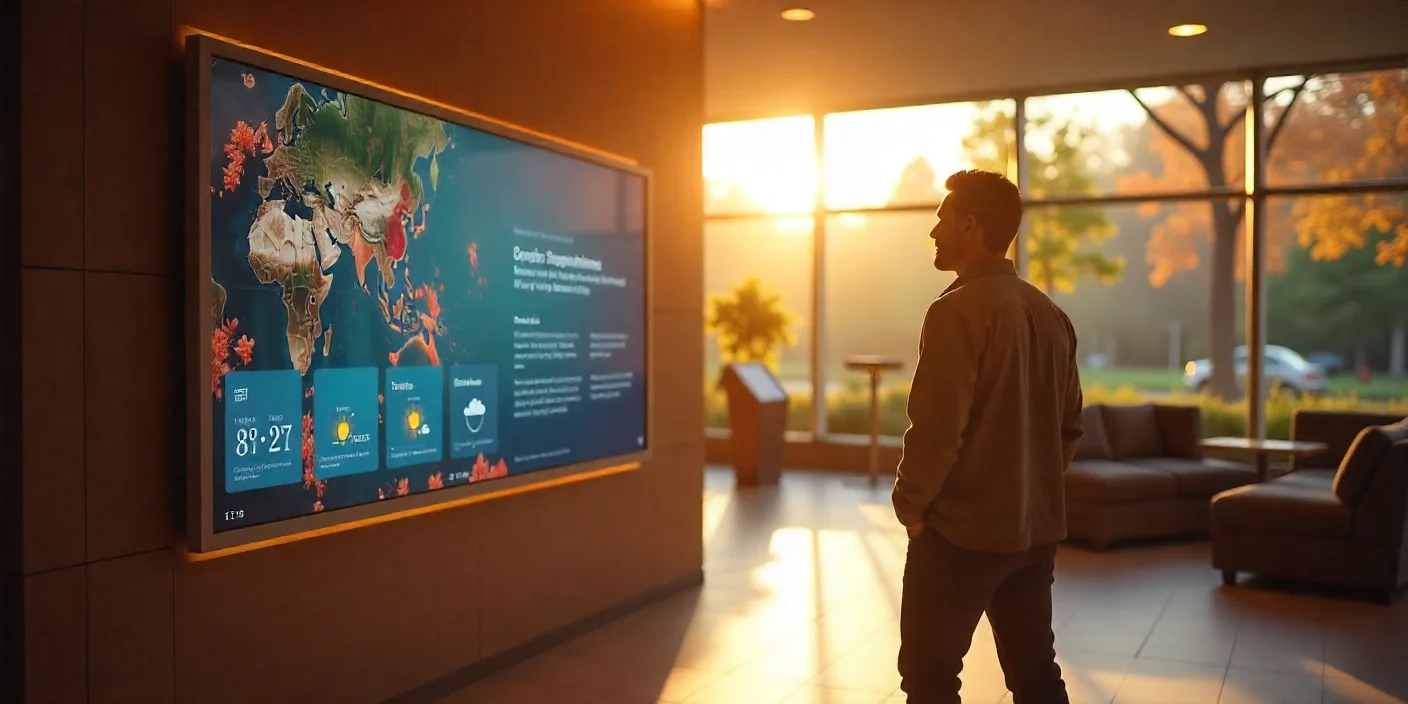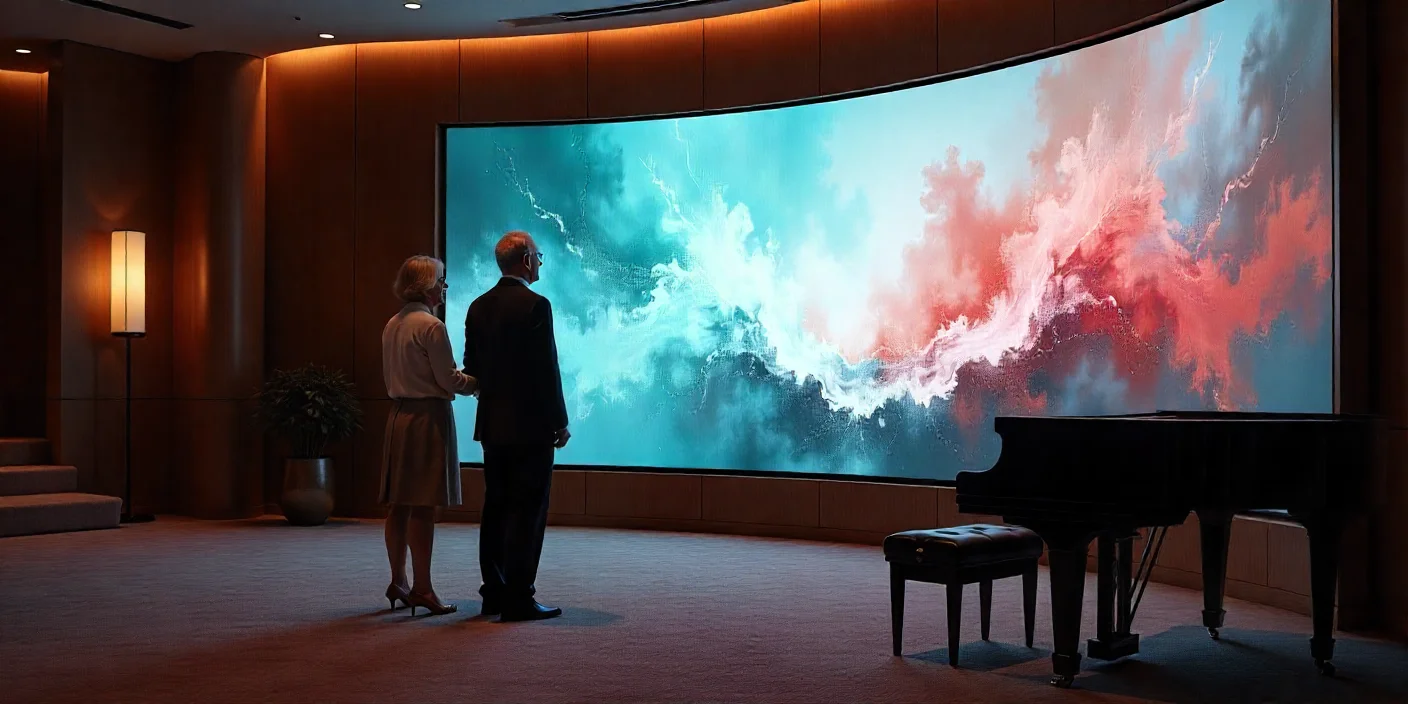In the competitive world of hospitality, something that no hotel tries to do is make experiences forgettable. One great tool that hotels have begun to adopt for better services is hotel lobby digital signage. This modern technology interests guests, improves operations, increases engagement, and provides dynamic information. This paper will touch on these aspects and get in-depth about how it benefits hotel lobby digital signage, how to implement it, what its future trends are, and a couple of case studies.
Understanding Hotel Lobby Digital Signage
Any digital screen that shows various content forms within the confines of the lobby area is what we refer to as digital signage. This ranges from LED screens and video walls to interactive kiosks. Digital signs in a hotel lobby include welcome messages, promotional offers, local information, or real-time updates. The dynamic aspect and versatility of digital signage make it an inalienable part of contemporary hotel operations.

The Rise of Digital Signage in Hospitality
The following have been some of the factors that have driven the adoption of digital signage in hotel lobbies:
- Technological Advancements: Advancements in display technology, software, and connectivity have made digital signage more accessible and affordable.
- Guest Expectations: The guests in the present time are more demanding and expect a high service level and convenience, which digital signage helps to provide.
- Operational Efficiency: Digital signage can automate and streamline many areas associated with hotel management, therefore decreasing the number of demands on the staff.
Key Benefits of Hotel Lobby Digital Signage
Enhanced Guest Experience
- Interactive Information: For visitors to have interactive information, digital signage can offer maps of events and local surroundings to complete their experience at the site visited and make it more accessible to be moved around in the hotel and surroundings.
- Personalized Welcome Messages: This will make the guest feel valued and appreciated right from the entrance to any hotel.
- Real-Time Updates: The content of the digital display may be in real-time, displaying updates to reflect events, weather, flight information, and more, ensuring visitors are armed with the most updated information.
Improved Operational Efficiency
- Streamlined Check-In Process: Interactive kiosks and digital signs can enable self-check-in and -out, resulting in lower wait times and freeing up staff time for other essential tasks.
- Centralized Management: Hotel employees can centrally manage digital signage content, controlling and updating it from a single location, ensuring uniformity and ease of management.
- Cost Savings: Digital signage saves costs over time by eliminating the need for printed materials and reducing the labor required to update traditional signs.
Marketing and Revenue Opportunities
- Promoting Hotel Services: Digital signs can highlight the services that the hotel provides, encouraging guests to use on-site amenities such as restaurants, spas, and fitness centers.
- Upselling and Cross-Selling: Advertise and promote special room upgrades, packages, and local tours through targeted advertisements and promotions.
- Event Marketing: Digital signage can inform customers about forthcoming events, provide event-specific information, and guide attendees.
Implementing Hotel Lobby Digital Signage
Choosing the Right Technology
- Display Types: Digital signage can be a simple LCD screen or a highly advanced LED video wall. High resolution and durability in the display are critical, depending on the needs and budget.
- Software solutions: User-friendly software that can integrate well with current hotel systems. Look for features like content scheduling, remote management, and real-time updates. Ready to see a platform that does it all? Explore Nento’s intuitive software solutions today.
- Connectivity: Good and reliable internet and network connectivity shall ensure good operation of digital signage and is most required for real-time content updating and interactive features.
Content Strategy
- Engaging visuals: Quality images, videos, and animations engage the customer in a way that sticks. Invest in the professional development of content to guarantee aesthetics.
- Dynamic content: Content has to be refreshed occasionally. Static information has to be blended with real-time updates, interactive elements, etc., which make the guest continue taking an interest in the presented material.
- Localization: The theme of the content should be localized according to the local culture, attraction, and the ongoing events of that time. It gives a sense of connection to the guests.

Design Considerations
1. Placement: The digital signage has to be placed in a location where it can be visible to as many eyes as possible. Keep digital signage in vital high-traffic areas like the entrance to the lobby, close to elevator landings, and at the reception desk.
2. Accessibility: Ensure that the digital signage is made accessible to all the guests, especially those with disabilities. Some considerations may include factors like the height of the screen, the design of the touch interface, and audio options.
3. User experience: The interface should be intuitive and self-explanatory. A guest should feel capable of locating information quickly without needing support.
Overcoming Challenges
Technological Barriers
1. Initial investment: As earlier mentioned, the digital signage initial cost could be colossal. However, in most cases, long-term benefits and savings will overtake the initial expenditure. Discover Nento’s flexible and scalable pricing options to find a solution that fits your budget
2. Maintenance: The digital signage system needs to be maintained at regular intervals to keep the solution at bay. This includes regular software updates, hardware repair, and content refreshes.
3. Technical support: Consistent technical support must be provided so that any challenge that may arise with the system can be handled within the least time possible.
Content Management
- Content Overload: Priority for key messages; rotate content to maintain its digestibility by the guest.
- Consistency: About the brand voice and visual style of the hotel, ensure that all content on digital signage is consistent.
- Monitoring performance: Use analytics to track the effectiveness of the digital signage. Such data will be helpful in informing future content strategies and any necessary improvements.
The Future of Hotel Lobby Digital Signage
Integration with Emerging Technologies
- Artificial Intelligence (AI): This makes digital signage interactive and personal through guest profiles and behaviors.
- Augmented Reality (AR): It creates virtual tours of the hotel or interactive guides to local attractions.
- Internet of Things (IoT): IoT devices make the data real-time, making digital signage more contextual and dynamic through, for example, occupancy sensors for content adjustment. Stay ahead of the curve. Learn how Nento is integrating AI and IoT to shape the future of guest experiences.
Sustainability and Environmental Impact
Sustainability is one method digital signage encompasses in the greening of the environment by not requiring paper to be used for communications or advertising and reducing waste. As hotels look toward being greener in many other ways, adopting digital signage meets a broader-reaching set of environmental goals.
Case Studies: Success Stories in Hotel Lobby Digital Signage
Luxury Hotels
Many luxury hotels have adapted digital signage into their decor for a more lavish guest experience. For instance, Ritz-Carlton enhances its guests’ experiences by having interactive screens through which local attractions, eateries, and events in the area are shared with them. Moreover, on those screens, a personalized welcome message is shown for the guests who stay there.
Business Hotels
Business hotels have resorted to using digital signage due to their ease of operation and the provision of critical information to guests. Business hotels have resorted to the use of digital displays like those at Marriot that display real-time information regarding the flight’s status, weather, and transportation options. Such information is valuable to business guests who rely on time-bound alerts.
Boutique Hotels
Boutique hotels use digital signs to signify their character and local charm. The Ace Hotel, whose eclectic design attempts to reflect the city it’s located in, has digital signage featuring local art and music events and neighborhood hotspots, all in a bid to create a personalized and immersive guest experience.
Inspired? See how Nento can help you craft a unique digital experience for your property

Conclusion
In building a better guest experience, more efficient operation, and a new avenue for marketing, digital signage within the hotel lobby has taken on a whole new role with hotels today. Properly executed and managed digital signage implementation allows the hotel to provide an active, engaging experience for its guests, thereby distinguishing the host from its competitors. When such innovation in technology is constantly evolving, the potential of digital signage inside hotel lobbies keeps growing. It has many more ways to offer innovation in delightful and innovative means of information.
In conclusion, investment in hotel lobby digital signage is a strategic move that may provide significant benefits. Whether it is about creating a welcoming atmosphere or driving revenues by promoting offers, digital signage can multitask and easily fit into any modern hotel. Looking ahead to the future, emerging technologies will further expand the capabilities of digital signage, helping it become more of a part of the guest experience than ever before.
Frequently Asked Questions (FAQs)
Q: How much does a basic hotel lobby digital signage system cost?
A: Costs can vary widely based on the size and type of displays (e.g., standard LCD vs. large video wall), the complexity of the software, and the scope of installation. A basic setup can start from a few thousand dollars, while a comprehensive, enterprise-level system will be a larger investment. Nento offers scalable solutions to meet any budget. Contact us for a customized quote.
Q: Is the content difficult to update and manage?
A: Not with a modern platform like Nento. Our cloud-based software is designed for ease of use, allowing hotel staff to drag-and-drop new content, schedule playlists in advance, and make real-time updates from any computer or mobile device—no technical expertise required.
Q: Can digital signage integrate with our existing hotel systems (PMS, event calendars, etc.)?
A: Absolutely. Leading digital signage solutions offer API integrations to pull data directly from your Property Management System (PMS) for personalized welcome messages, from event management software to display conference schedules, and from data feeds for weather and flight information. Ask our experts about Nento’s integration capabilities.





